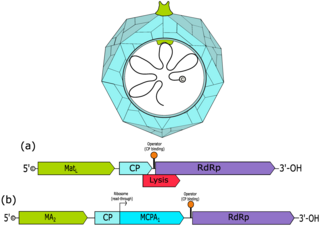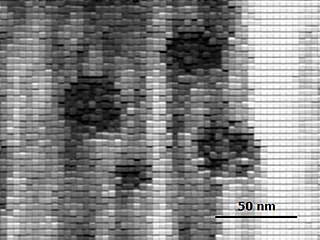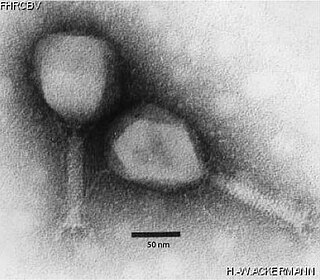
Leviviridae is a family of positive-strand RNA viruses which infect prokaryotes. Bacteria, including enterobacteria, caulobacter, pseudomonas, and acinetobacter serve as natural hosts for these bacteriophages. They are small viruses with linear, positive-sense, single-stranded RNA genomes that encode four proteins. All phages of this family require bacterial pili to attach to and infect cells. There are currently four species in this family, divided among two genera.
Teschovirus is a genus of viruses in the order Picornavirales, in the family Picornaviridae. Pigs serve as natural hosts. There are currently two species in this genus, including the type species Teschovirus A, which is responsible for the porcine enteroviral encephalomyelitis disease caused in pigs. The genus name comes from its type species and the disease it causes: Teschen disease, which itself was named for the town in the Czech Republic where the disease was first recognised in 1929.

Marnaviridae is a family of positive-stranded RNA viruses in the order Picornavirales. The first marnavirus that was isolated, and which is the type species for the family, infects a Microphyte: the toxic bloom-forming Raphidophyte, Heterosigma akashiwo. Algae therefore seem to serve as natural hosts. There is only one genus (Marnavirus) and one species in this family, the type species Heterosigma akashiwo RNA virus (HaRNAV).
Uetakevirus is a genus of viruses in the order Caudovirales, in the family Podoviridae. Bacteria serve as natural hosts. There are currently three species in this genus, including the type species Salmonella virus Epsilon15. These phages are temperate and infect Salmonella and Escherichia coli.

Virgaviridae is a family of positive-strand RNA viruses. Plants serve as natural hosts. The name of the family is derived from the Latin word virga (rod), as all viruses in this family are rod-shaped. There are currently 59 species in this family, divided among seven genera.
Tequatrovirus is a genus of viruses in the order Caudovirales, in the family Myoviridae, in the subfamily Tevenvirinae. Gram-negative bacteria serve as the natural host, with transmission achieved through passive diffusion. There are currently 21 species in this genus, including the type species Escherichia virus T4.

Tevenvirinae is a subfamily of viruses in the order Caudovirales, in the family Myoviridae. Bacteria and archaea serve as natural hosts. There are currently 77 species in this subfamily, most included in 11 genera.
Muvirus is a genus of viruses in the order Caudovirales, in the family Myoviridae. Bacteria serve as natural hosts, with transmission achieved through passive diffusion. There are currently two species in this genus, including the type species Escherichia virus Mu.

Teseptimavirus is a genus of viruses in the order Caudovirales, in the family Autographiviridae, in the subfamily Studiervirinae. Bacteria serve as the natural host, with transmission achieved through passive diffusion. There are currently 17 species in this genus, including the type species Escherichia virus T7.
Tequintavirus is a genus of viruses in the order Caudovirales, in the family Demerecviridae. Bacteria serve as the natural host, with transmission achieved through passive diffusion. There are currently 22 species in this genus, including the type species Escherichia virus T5.
Tunavirus is a genus of viruses in the order Caudovirales, in the family Drexlerviridae. Bacteria serve as natural hosts. There are currently 14 species in this genus, including the type species Escherichia virus T1.

Allolevivirus is a genus of positive-strand RNA viruses, in the family Leviviridae. Enterobacteria serve as natural hosts. There are currently only two species in this genus including the type species Escherichia virus Qbeta.

Alphanodavirus is a genus of non-enveloped positive-strand RNA viruses in the family Nodaviridae. Insects, mammals, and fishes serve as natural hosts. Diseases associated with this genus include: Nodamura virus paralysis in infected wax moth larvae. Member viruses can also provoke paralysis and death to suckling mice and suckling hamsters. There are five species in this genus including the type species Nodamura virus.
Bullavirinae is a subfamily of viruses in the family Microviridae. Enterobacteria serve as natural hosts. There are currently 14 species in this subfamily, organized into three genera.

Mitovirus is a genus of positive-strand RNA viruses, in the family Mitoviridae. Fungi serve as natural hosts. There are five species in the genus including the type species Cryphonectria mitovirus 1.
Alvernaviridae is a family of viruses. Dinoflagellates serve as natural hosts. There is currently only one species in this family: the type species Heterocapsa circularisquama RNA virus 01. Diseases associated with this family include: control of the host population possibly through lysis of the host cell.

Carmotetraviridae is a family of viruses; there is currently only one genus in this family, Alphacarmotetravirus, and one species in this genus, the type species Providence virus. Lepidopteran insects serve as natural hosts.
Dicipivirus is a genus of viruses in the order Picornavirales, in the family Picornaviridae. Dog serve as natural hosts. There are currently two species in this genus including the type species Cadicivirus A.
Mosavirus is a genus of viruses in the order Picornavirales, in the family Picornaviridae. Canyon mouse serve as natural hosts. There are currently two species in this genus, including the type species Mosavirus A.
Rosavirus is a genus of viruses in the order Picornavirales, in the family Picornaviridae. Human and rodents serve as natural hosts. There are currently three species in this genus, including the type species Rosavirus A.









